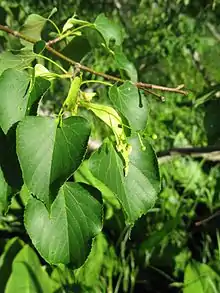Tilia japonica
Tilia japonica, the Japanese lime or Japanese linden, is a species of Tilia native to eastern China and Japan, preferring to grow in mountains up to 2000 m. It superficially resembles the better-known Tilia cordata, the small-leaved lime, and was originally described as Tilia cordata var. japonica. It differs from T. cordata in having 164 chromosomes instead of 82, and by some subtle differences in leaf and flower morphology. T. japonica inflorescences consistently have 5 staminodes, which is a reliable trait distinguishing it from T. cordata and T. amurensis.[3]
| Tilia japonica | |
|---|---|
 | |
| Scientific classification | |
| Kingdom: | Plantae |
| Clade: | Tracheophytes |
| Clade: | Angiosperms |
| Clade: | Eudicots |
| Clade: | Rosids |
| Order: | Malvales |
| Family: | Malvaceae |
| Genus: | Tilia |
| Species: | T. japonica |
| Binomial name | |
| Tilia japonica | |
| Synonyms | |
| |
Cultivation and uses
Tilia japonica is grown as an ornamental tree. Its 'Ernest Wilson' cultivar has gained the Royal Horticultural Society's Award of Garden Merit.[4] Its wood was used for furniture, and due to its straight grain is still occasionally used for veneers. Like other lindens, it is a source for a honey. It is the official tree of the city of Nagano, Japan.
References
- Math. Természettud. Közlem. 12:326. 1888
- Ann. Mus. Bot. Lugduno-Batavi 3:18. 1867
- Pigott, Donald (2012). Lime-trees and Basswoods: A Biological Monograph of the Genus Tilia. Cambridge University Press. p. 150-155. ISBN 9780521840545.
- "AGM Plants - Ornamental" (PDF). Royal Horticultural Society. November 2018. Retrieved 26 August 2019.